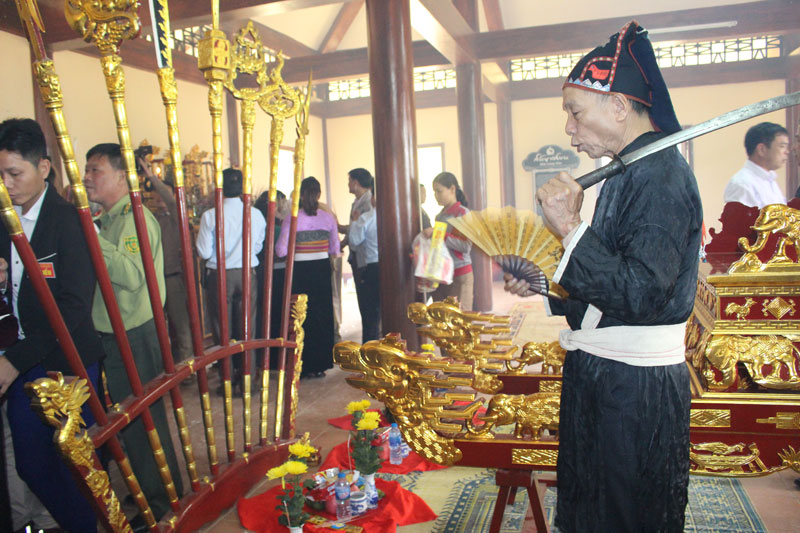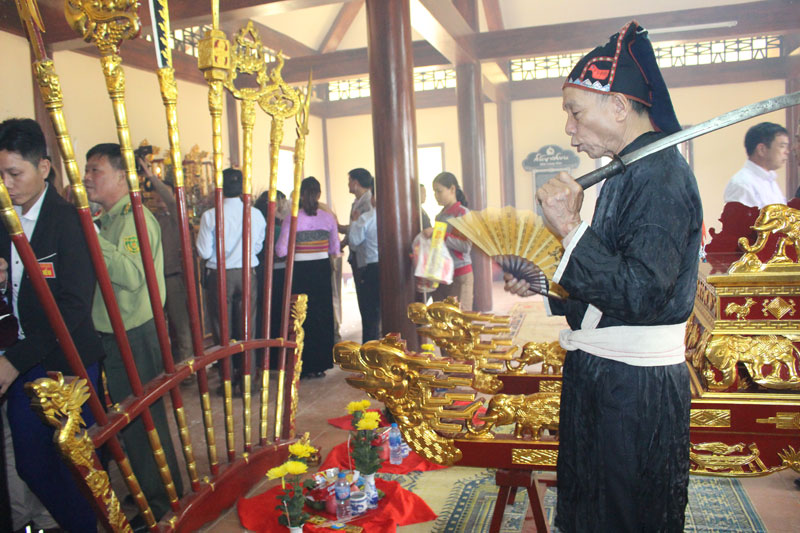
HBO – The Xen Muong festival of the Thai ethnic group is held in early Spring to pray for good harvest, luck and safety. The festival is an occasion to introduce the original cultural values of the Thai to visitors, and also a place for young people to show off their talents in singing and Khen (panpipe) playing.

A shaman performs a ritual at the Bon Village temple during
the Xen Muong festival
Visitors to the festival
will have the chance to listen to the recital of an epic on the local Thai
ethnic group’s history from the early days they set up the villages. It is said
that Chieng Chau was the first place of settlement of the Thai group when they
migrated from Bac Ha (Lao Cai) in the 13th century. Through many ups
and downs, generations of Thai landlords deserved credit for leading locals in
reclaiming forest lands to set up villages. During the Later Le Dynasty, the
Thai landlord in Mai Chau made a great feat in fighting invaders from the
north, and was rewarded with the title "Tuoc hau dai tu khau truc trung hau”
(called in short Tuong Su by the Thai locals).
The Xen Muong festival
highlights the traditional cultural values of the Thai group. It begins with
rituals performed by a shaman, who must be a person respected by all in the
community. On the main stage, the shaman reads prayers in Thai language. He
then leads a procession taking the Tuong Su’s palanquin to the temple of Bon
village, followed by other worshipping rituals. The prayers reflect the adoration
and respect for Thai landlords who contributed greatly to the foundation of
Thai villages. The shaman serves as a bridge between generations of Thai people
with their ancestors.
The vitality of the Xen
Muong festival also comes from the originality of Thai culture and folk dances
and songs./.
Located just a 20-minute drive from Hoa Binh City, Ora Hill Farmstay & Glamping Hoa Binh is a captivating new destination nestled in Mo hamlet, Bình Thanh commune, Cao Phong district. Combining farming with leisure, this tranquil retreat is perfect for those seeking balance, joy, and an immersive experience in the expansive beauty of nature.
Muong Bi - Tan Lac is renowned as one of the four famous Muong regions in Hoa Binh province. Blessed by nature with a favourable climate and stunning landscapes, Tan Lac holds great advantages for tourism development. The local tourism industry has made remarkable strides in recent times thanks to the attention and support from the local authorities and sectors.
With its strategic location, well-developed transport network, and diverse soil and climatic conditions, Hoa Binh is emerging as a must-visit destination in Vietnam's northwestern tourism corridor. The province boasts numerous attractions, including the Kim Boi hot springs (Kim Boi district), the Dau Rong cave complex (Cao Phong), the Mai Chau valley (Mai Chau), and the iconic Hoa Binh hydropower plant.
The northern mountainous province of Hoa Binh has been listed among the 71 most beautiful places to visit worldwide by the prestigious US travel magazine Condé Nast Traveller.
Hoa Binh province’s rich natural and cultural resources position it as a prime location for developing community-based tourism (CBT). In recent years, support from central and provincial policies, as well as assistance from non-governmental organisations, have encouraged local ethnic minority and mountainous communities to actively engage in the sector.



